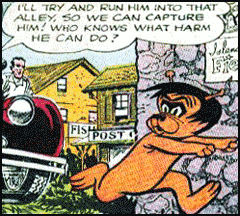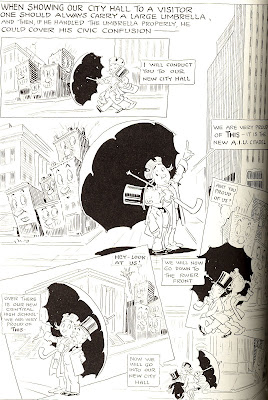Damn, I thought, I should really be doing something constructive while watching/listening to this stuff—it’s not like I need 100% of my attention to follow this.
Looking around for something constructive to do, I came up empty.
It’s about that time that I usually decide that if I can’t do something genuinely constructive, I could at least write a blog post.
And this is that post! So here then is a guided tour of the comics art (and comics-like art) in my apartment, all photographed with the tiny little camera embedded in the top of my laptop screen, which reverses lettering in images for some reason I don’t understand (it has something to do with magic, I believe), while I was half watching the State of the Union speech.
Ready?
Here in my living room are two prints of covers from 2002 Marvel miniseries Deadline:

Here are better images of the covers; the prints are the same, but larger, and devoid of text:


I really liked this miniseries, written by Bill Rosemann and featuring interior art by Guy Davis. I’m a bit biased in that I was a reporter at the time, and I always find comics about reporters inordinately exciting*, and here was a brand new reporter working the super-hero beat in the Marvel Universe. Plus, she was totally hot.
We never got another mini featuring Kat Farrell, but I believe she showed up in the first issue or two of Young Avengers and maybe in The Pulse?
Anyway, I bought these two prints from artist Greg Horn who was selling his prints of his work at one of the Mid-Ohio Cons I attended. He remarked about how those images were different than most of his others in that she sure was wearing a lot of clothes. Hell, she’s got a parka on.
Not that I wouldn’t have bought any images of a scantily clad Farrell that Horn had; this just happened to be that rare Greg Horn Marvel cover work that didn’t involve a scantily clad woman.
I like a lot of Horn’s art in general; his She-Hulk covers in particular tend to be pretty good. But then, many of his Ms. Marvel covers are mind-bogglingly unappealing to me, so I don’t know, maybe the characters and concepts that play into his cover work determine the quality—or my appreciation of the quality—to a large degree.
Right next to that hangs a print of a concert poster by Cleveland’s Derek Hess, who’s been one of my favorite artists since I was a teenager.

You’ve probably heard of Hess before and, if not, cruise his site a bit. He gained acclaim as an artist while working to promote music shows in Cleveland; he would design the posters for shows he was putting on, and they were awesome.
He tended to work literal interpretations of the bands’ names into the images, often with quite interesting results. For example, a poster for a Jesus Lizard show might have Jesus surfing on the head of a rampaging Tyrannosaurus Rex. He’s since moved on to focus much more on non-rock poster related art, although his interest in music still fuels a lot of his other endeavors, including a line of clothing and his music festivals.
What’s he got to do with comics? Um, not much, really. Although he is a huge Captain America fan, particularly the old school ‘60s and ‘70s Cap who he grew up reading and admiring.
And Hess did provide the cover art for the 2002 miniseries Captain America: Dead Men Running by Darko Macan and Daneil Zezelj (Which I’ve never read. Have any of you? Is this any good?).
Here’s one of them:

The print I have is of a 1997 poster for a show featuring Man or Astro-Man?, a band I liked quite a bit back then, despite their avant garde usage of punctuation. The poster features a man standing in a tea cup which is on a saucer, and they’re flying through the air. In other words, he’s on a flying saucer. Get it?
Anyway, the piece has a lot of sentimental value for me. It was given to me by my then girlfriend for my birthday, it was the first piece of fine art I owned, it was by one of my favorite artists, it featured one of my favorite bands at the time, and the show was even sponsored by the radio station I used to listen to in high school which now, sadly, no longer exists.
In fact, the only piece of art I own which I value more is this:

But it’s hard to compete with a black velvet Jimi Hendrix passed down from your father, you know?
Next on your tour of my living room walls in this print, a reproduction of a page from Farel Dalrymple’s Pop Gun War, which is a very excellent comic book:

If you’re unfamiliar with Dalrymple’s PGW or his contributions to some excellent AdHouse anthologies, you may know his work from the new version of Omega the Unknown that Marvel is currently publishing.
I bought this piece one year at SPACE a couple of years ago. I don’t think Dalrymple was actually in attendance that year though; if my memory serves, one of his Meathaus peers was selling prints of his.
Next we have this lovely piece by Columbus’ own Adam Brouillete, probably my favorite Columbus-based fine artist:
 (Please note the shadow of my laptop obscuring the image. I really am a fantastic photographer)
(Please note the shadow of my laptop obscuring the image. I really am a fantastic photographer)To explain why I like Brouillette’s art so much would risk getting on a long-ass tangent here, but suffice it to say he covers some of the most awesome subjects in a very awesome visual style.
Here, for example, is an image of Thor shooting lightning bolts out of his beard while some totally Nordic looking guys play battle axes like guitars atop a storm cloud full of skulls. Here is a many-eyed squid that is sick in the south pole, surrounded by blank-eyed penguins on ice floes, a submarine, and a whale that seems to be totally freaking out about something.
The above image is entitled “Moral Issue.” I bought that one from a gallery show. Brouillette’s original art is pretty affordable for original art. If I were a millionaire, I would own a lot of it, but even as a hundrednaire, the little pieces are within my budget.
I do have one other piece by him, which was given to me by a former roommate:

It’s entitled “Phenomenon,” and depicts one of Brouillette’s signature little red men doing a wicked motorcycle stunt off a ramp.
Hanging right above that is the work of another Columbus artist, Paul Volker:

It’s entitled “Octopus With Hindenberg,” and should prove pretty self-explanatory. Please visit his completely insane site some time and check out his completely insane work—even the list of title’s is funny. It’s also remarkably affordable, which probably explains why it hangs on the walls of so many of the people’s houses I’ve been inside of in Columbus.
The final piece of cartoony, Columbus-generated art I have is this one by Rob Jones. (I think it was “Rob,” I only met him once, to buy it).

It’s entitled “Squid First,” and is, as you can see, a painting of a cute squid over a rising sun motif. It’s painted onto a piece of a rainbow bedsheet that has been stretched over a wooden frame, forming a cheap-ass canvas (“Cheap-ass” being something I look for in all the original art I own).
It says “Saki Ika” and “Konichiwa,” the former meaning “squid first” in Japanese, and I’m sure you know what the latter means.
I totally love cephalopods.
Here we have a picture of J’onn J’onnz done in crayon:

It was drawn on a backing board, so I put it in a plastic bag when I hung it up. You may not believe this, but it only cost me $1! I bought it from the artist at Mid-Ohio Con. I have a few more, too, which I haven’t gotten around to hanging up yet.
Check ‘em out:




That was easily the best $5 I’ve ever spent at a con. Sadly, I can’t remember the artist’s name, so I can’t sing his praises here. I want to say it was Grant Baker, based on the signature on the back, but I can’t be sure:

Does that look like “Grant Baker” to you? I don’t know. If that looks familiar to you though, lemme know, huh?
And this is another print I bought at Mid-Ohio:

It’s by Marc Hempel, the extremely talented artist responsible for The Sandman arc “The Kindly Ones,” probably the most idiosyncratically illustrated arc of the series. It’s entitled “Nature Girl” and is of a naked lady. I have never been able to find a cheap frame to fit it, and I’ve always been too poor to have it custom-framed, so it’s been not hanging in two different apartments for…oh, maybe three or four years now.
And that is all the comic book and/or vaguely comic book-like art I own.
*Except for Paul Jenkins’ Sally Floyd from Frontline. I really detest her/the scenes Jenkins writes featuring her. Like that one where she told Captain America he sucks cause he’s not on myspace?


































